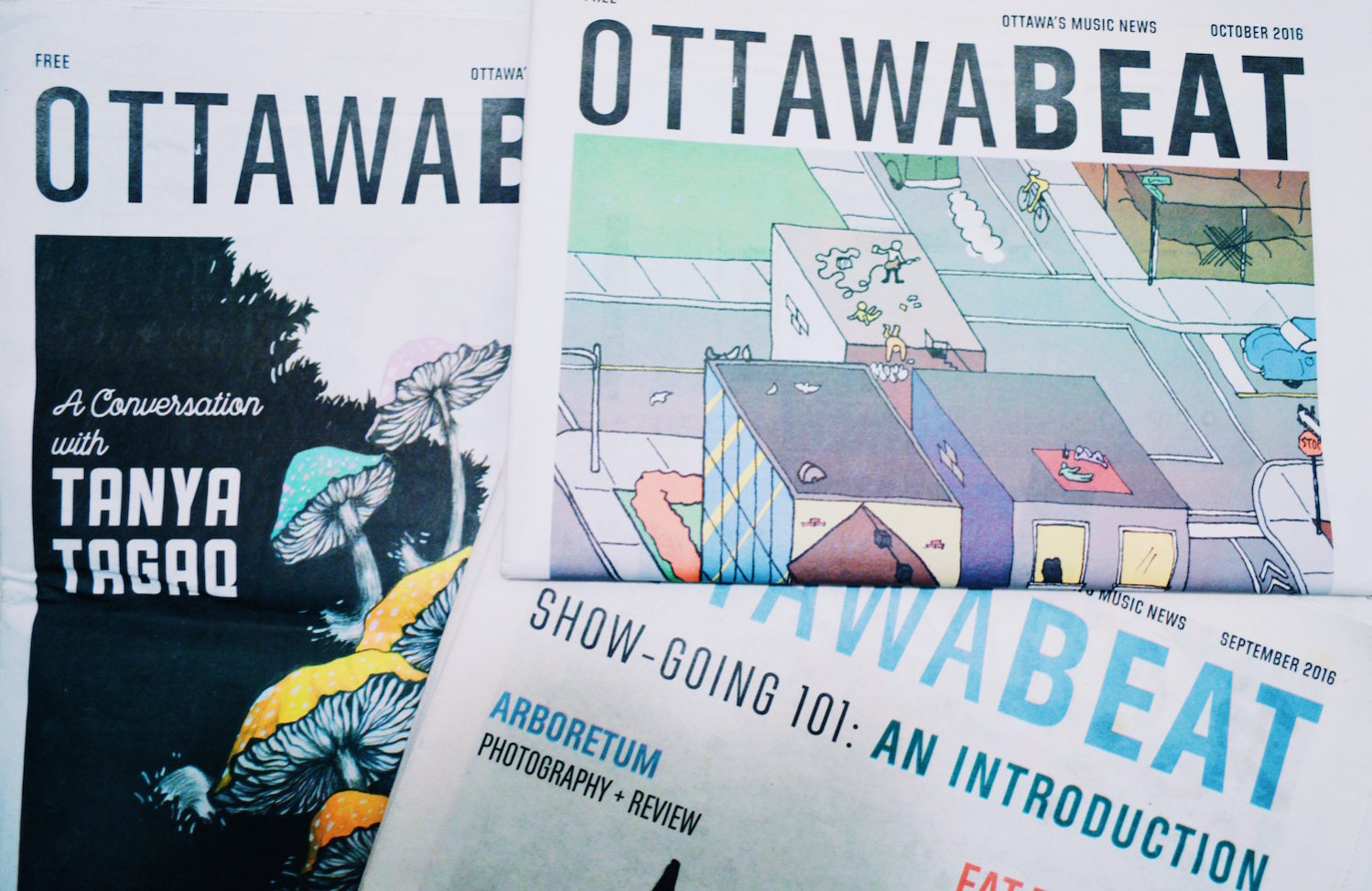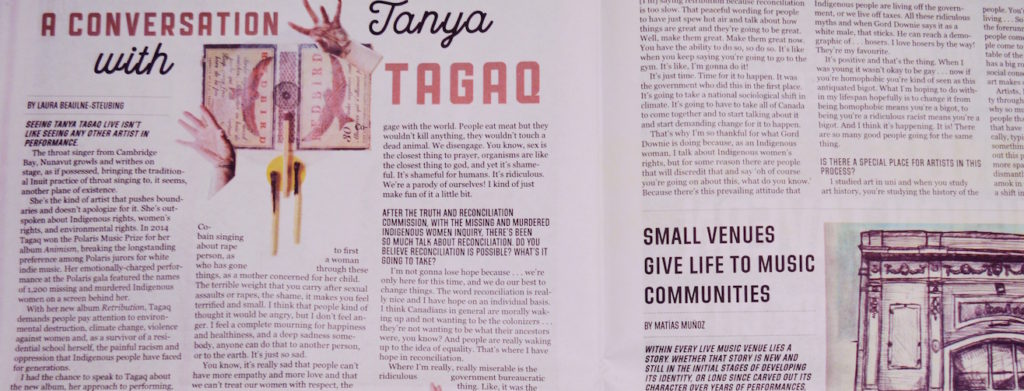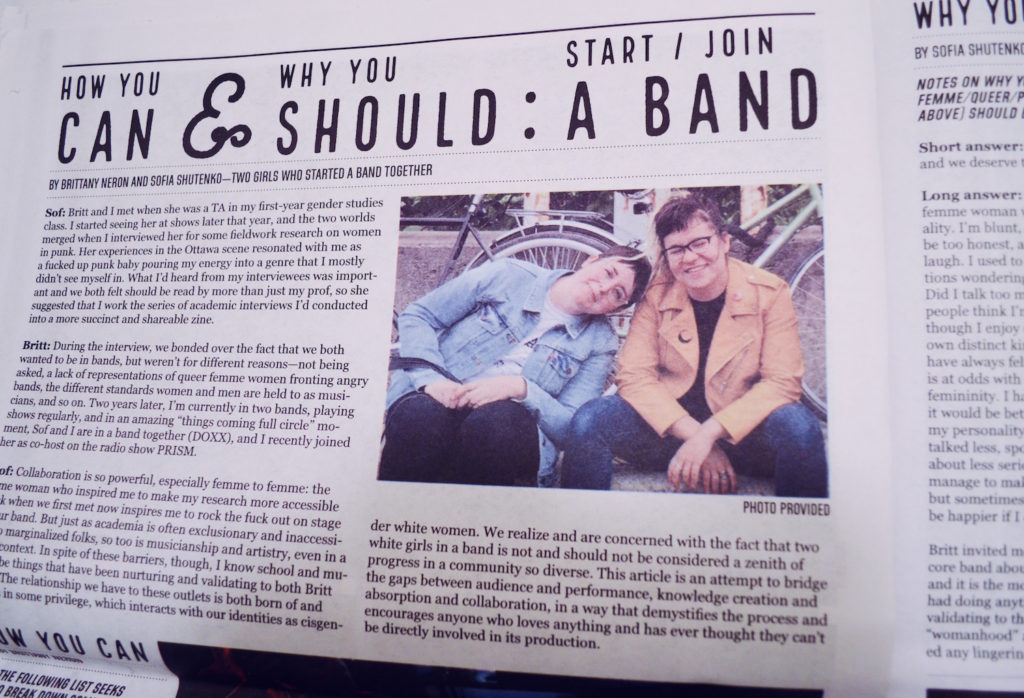Spotlight Series: Ottawa beat music newsprint thrives

In 2012, Ottawa said goodbye to (x)press, its once-homey hub of alternative and independent arts journalism. Since then, a vibrant collection of music blogs, art collectives and start-up companies have scattered across the capital, but nothing truly filled the void of the weekly arts newspaper- until this past summer.
In June, Ottawa Beat, the monthly, independent, locally-created paper was born. Run by Luke Martin and edited by Adella Khan, the publication has since developed a circulation of 5000; reaching hands via indie cafes, record shops, clothing stores, and more. The paper’s articles and illustrations – all crafted by capital region artists – cover concerts, festivals, and arts events, provide commentary on music culture, and spotlight local bands. With each month that goes by, the paper develops a larger readership and covers a wider scope relating to local music; Beat’s latest issue (November 2016) featuring an interview with renowned Canadian artist Tanya Tagaq.
The paper’s beginnings are parallel to the recent changes in Ottawa’s music industry. While the past few years have seen a number of beloved venues close down, new and innovative spots have taken their place – a quite literal example is the closure of Raw Sugar and the opening of Bar Robo. While the city still struggles with accessibility, all-ages shows are on the rise thanks to inviting venues, outdoor festivals, and what seems to be a slow but prominent shift in the attitude of Ottawa’s music scene. Ottawa Beat is a near perfect embodiment of these changes – its eclectic writing spotlights underground music but is inviting to everyone. Supported by small advertisements, the paper is a thriving model of near-independent success, curated by a growing number of local artists who are bound by their appreciation of music and belief that (even within a stereotypically cold government city), local music is a gift, one that needs to be shared.
Creating a music publication was something that Luke Martin, the owner of Capital Rehearsal Studios and Gabba Hey, had thought about since the end of (x)press. A quiet but integral member of the Ottawa music scene for two decades, Martin saw the need for a new music publication, one that would better encompass the city’s young and growing industry.
In search of partners with a writing background, mutual friends led Martin to Adella Khan, a graduate of Carleton University’s journalism program. “She’s a community builder,” he says of Khan, who was previously Editor-In-Chief of The Charlatan and a contributor for CanCulture. Her writing experience, logistical knowledge, and understanding of local arts culture were the set of skills needed to materialize Martin’s idea. Khan works with a growing number of contributors to create the monthly paper; an undoubtedly difficult project, one that she’s handled gracefully.
While Capital Rehearsal Studios has recently closed its doors as a venue (known in the community as Gabby Hey), Martin continues to offer an accessible place for local independent bands to get their footing. Not limited to Gabba Hey, his business endeavours in the Ottawa arts have provided the necessary support for young and self-sufficient artists to thrive.
Supporting young artists remains Martin’s main goal in his managerial position at Ottawa Beat. In Ottawa (unlike larger, more perceptibly “artistic” cities like Toronto), there remains an anxiety around promoting one’s music and seeking a following. Martin hopes to break that barrier down, not only through promoting artists’ work, but also by providing the resources needed to grow. Gabba Hey’s rehearsal space was arguably the best example of this, and it will be difficult to replace. But with the city’s growing number of intimate venues, community music events, and independent recording projects, the future looks bright.
While the paper stays true to its catchphrase, Ottawa’s Music News, it encompasses a wide scope of issues pertaining to the local arts, with essays written from a range of perspectives. Examples include articles providing insight into entertainment law (a monthly piece in the paper’s Music Industry section, written by Byran Pascoe), the struggles of making time for music (The Art of Balancing Family, Work and Music by Adriana Ciccione), and the difficulties of establishing a band (How You Can/Why You Should Start/Join a Band by Brittany Neron and Sofia Shutenko). The paper also features a Babely Shades column, bringing awareness to inequalities in the music scene and providing a much-needed platform for local minorities to reach a wide audience when voicing their experiences.
The paper’s categories (which include Photography, Food, Comics, and Radio, among others), maintain a broad artistic scope within the context of local music, providing a unique collection of stories each month. In this sense, Ottawa Beat should be confident in their future – specialty print can be repetitive, but the paper’s versatility and scope ensures a wide readership and room for growth and change.
Ottawa Beat has also quickly established itself as a means of interconnection and communication within the local arts community. The paper features a monthly itinerary of local shows, uses original artwork for each issue’s cover, and shines light on both the developments in the local music scene as well as its pitfalls and need for improvements. Its newfound prominence in the city provides an incredibly accessible platform for artists to meet, converse, share their opinions, and promote their work; regardless of age, background, genre, or experience. Beat prides itself on its safe-space mentality, arguing for more equal and inviting opportunities for minorities in Ottawa and ensuring the paper remains an engaging platform for artists of all kinds. Providing a communicative space was important to Khan, who says many artistic hubs in Ottawa may be exclusive to a certain group or genre. With Beat, she hopes to provide a place for “interconnectivity within these scenes”.
Ottawa Beat has only been around for a few months, but its rapid growth is obvious. As each month goes by, the paper seems more cohesive, while maintaining the individuality of a local, small-scale and specialty publication. Its articles are refined, even when the paper runs a few pages longer than before. It balances lengthy, almost academic essays and interviews with shorter, informal pieces such as concert reviews and original comics. It provides an alternative, realistic and unapologetic portrayal of Ottawa’s music industry, a young scene that still struggles with exclusivity and judgment.
For the future, both Luke and Adella look forward to growth, as do Beat’s readers. The paper recently hired a Social Media Coordinator, and Khan says that employing more writers is a critical goal going forward, as is inviting more original work from visual artists and photographers. While Beat’s first growing pains may be over, it will certainly continue to evolve along with its readership and context.
Ottawa Beat is not only an example of local success, but of community. Both Martin and Khan stress the importance of variety and support in the paper’s future, promoting the work of musicians but also highlighting the behind-the-scenes work of producers, technicians, and businesspeople through the paper, its affiliates, and local programs. Just as local musicians and venues have leaned on Ottawa Beat for promotion and awareness, the paper relies on activity within the music scene in order to flourish. As more independent venues, companies and coalitions come forward, the interdependent relationship between Beat and the city’s music scene will only get stronger, and the paper will undoubtedly continue to grow. Adella Khan says it best herself when asked about the future of Ottawa Beat – “It’s only getting better”.


